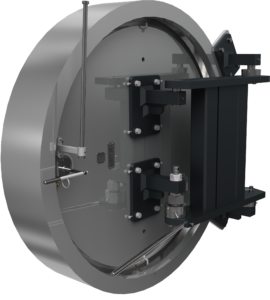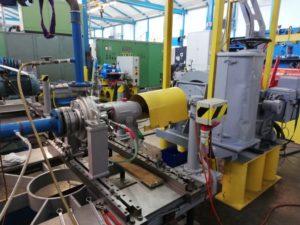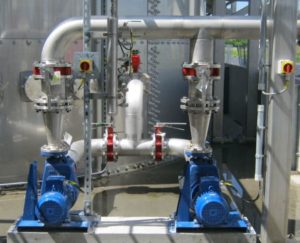Baker Hughes Announces First Quarter Results
Baker Hughes Incorporated announced results for the first quarter of 2015.
Revenue for the first quarter of 2015 was $4.6 billion, down 20% compared to the first quarter of 2014.
On a GAAP basis, net loss attributable to Baker Hughes for the first quarter was $589 million or $1.35 per diluted share.
Adjusted EBITDA (a non-GAAP measure) for the first quarter of 2015 was $458 million, a decrease of $589 million or 56% compared to the first quarter of 2014.
Adjusted net loss (a non-GAAP measure) for the first quarter of 2015 was $32 million or $0.07 per diluted share. Adjusted net loss for the first quarter excludes $772 million before-tax or $557 million after-tax ($1.28 per diluted share) in adjustments. The adjustments include restructuring charges of $573 million before-tax or $415 million after-tax ($0.95 per diluted share) associated with severance charges, facility closures, asset impairments, and contract terminations; $171 million before-tax or $122 million after-tax ($0.28 per diluted share) for inventory adjustments; and $28 million before-tax or $20 million after-tax ($0.05 per diluted share) relating to merger-related costs.
Additional charges of $157 million before-tax, or $133 million after-tax ($0.30 per diluted share), were incurred in the first quarter, which includes $105 million relating to reserves for doubtful accounts and $52 million associated with inventory reserves. Although these charges were significant and largely market-driven, they were not categorized as adjustments, and therefore not excluded from adjusted net operating loss.
Free cash flow for the current quarter was $22 million, compared to ($36) million for the first quarter of 2014.
For the first quarter, capital expenditures were $315 million, compared to $439 million in the first quarter of 2014. Depreciation and amortization expense for the first quarter was $460 million, compared to $437 million in the prior year quarter.
Excluding merger-related costs of $28 million in the first quarter, corporate costs were $49 million, compared to $65 million in the first quarter of 2014. The reduction in corporate costs is primarily the result of recent cost reduction measures.
North America
North America revenue for the first quarter was $2 billion, which was a decrease of 28% compared to the first quarter of 2014. The decline in revenue was primarily driven by a sharp drop in onshore and shallow water activity. Compared to the first quarter of 2014, the average U.S. rig count decreased 21%, which includes a decline of approximately 880 rigs, or 48%, year-to-date. Activity reductions were further exacerbated in the U.S., where it is estimated that as many as 20% of the wells drilled in the first quarter were placed in inventory, uncompleted. Canada, which normally sees peak activity levels in the first quarter, instead experienced a pronounced drop in activity as customers elected to halt operations earlier than normal. Compared to the first quarter of last year, Canadian rig counts were 40% lower this year. Activity was also down in the Gulf of Mexico as shallow water rig counts dropped 30% on average versus the prior year quarter. The drop in drilling activity and well completions across North America negatively impacted all product lines. Additionally, capital-intensive product lines such as pressure pumping, coiled tubing, and wireline services experienced a significant oversupply of equipment in the market. Deepwater operations in the Gulf of Mexico remained steady, including increased completions activity and solid utilization of the company s fleet of stimulation vessels.
North America adjusted operating profit margin (a non-GAAP measure) was (2.5%) for the first quarter, representing a decrease of 1,330 basis points compared to the first quarter of 2014. Margins were impacted by the strong drop in activity resulting in reduced demand and unfavorable market conditions. Profit was further impacted by $26 million in reserves for doubtful accounts and inventories. Over the course of the quarter, a number of actions were initiated to restructure North American operations for improved profitability in a lower activity environment. These actions include workforce reductions, facility closures, and inventory adjustments. Additionally, underutilized assets were idled or impaired altogether. Actions were also taken to secure improved commercial terms with vendors, resulting in lower cost of goods sold, and reduced freight charges. The actions taken to restructure operations and reduce cost partially offset the activity-driven losses during the quarter. As such, North American decremental margins were 41% sequentially and substantially lower than the decremental margins from the most recent downturn in 2009.
In the second quarter, North America rig counts are anticipated to continue declining across all onshore and shallow water markets. In contrast, deepwater rig counts in the Gulf of Mexico are expected to remain stable and to include a favorable mix of completions activity. In aggregate, the North American rig count throughout the second quarter is projected to decline approximately 350 rigs, or 30%, compared to the first quarter exit rig count. As the quarter progresses, the pace of rig count declines is anticipated to slow.
Latin America
Latin America revenue was $493 million for the first quarter, a decrease of $37 million, or 7%, compared to the first quarter of 2014. The reduction in revenue can be attributed to activity declines in the Andean area, as reflected in a 24% decline in the rig count, and revenue declines in Venezuela from both lower rig count activity and unfavorable exchange rates as a result of the currency devaluations that occurred in the second quarter of 2014. These reductions in revenue were partially offset by share gains in Mexico s marine region, increased unconventional activity in Argentina, and share gains in Brazil as a result of a recent drilling services contract.
Adjusted operating profit margin for Latin America in the first quarter was 9.1%, representing a drop of 180 basis points compared to the prior year quarter. Not unlike revenue, profitability was impacted by reduced onshore activity levels, along with $14 million in reserves for doubtful accounts and inventories, and $5 million for a currency devaluation in Venezuela as the company adopted the prevailing market rate of 192 Venezuelan Bolivars per U.S. Dollar.
In the second quarter, the Latin America rig count is projected to drop less than 5%. However, this forecast includes a decrease of five deepwater drilling rigs in Brazil relating to demobilization of a local drilling rig supplier facing potential bankruptcy. The reduction of deepwater activity is expected to have a negative impact on second quarter results.
Middle East/Asia Pacific
Revenue was $916 million in Middle East/Asia Pacific for the first quarter, which was a 14% decrease compared to the first quarter of 2014. The revenue decline was largely attributable to the significant reduction of integrated operations in Iraq in the first quarter, along with the exiting of a large turnkey contract in mid-2014. Revenue was also impacted by reduced activity throughout Asia Pacific as reflected in a 9% drop in the rig count. Additionally, the Middle East encountered pricing pressure in the first quarter. The decline in activity and unfavorable pricing was partially offset by strong demand for drilling services and completion services product lines driven by a significant increase in the Saudi Arabian rig count compared to the prior year quarter.
Adjusted operating profit margin for the segment was 6.8%, a decrease of 610 basis points versus the prior year quarter. The decrease in profitability is attributed primarily to reduced activity levels and unfavorable pricing, along with $32 million in reserves for doubtful accounts and inventory. The reduction in margins was slightly offset by improved profitability in Iraq.
For the second quarter, rig count declines in North Asia, Australia, Indonesia, and Iraq should be partially offset by increased activity in Saudi Arabia and the surrounding Gulf States. In total, the Middle East/Asia Pacific rig count is projected to drop by less than 5% versus the first quarter.
Europe/Africa/Russia Caspian
First quarter revenue for this segment was $895 million, representing a 14% decline compared to the first quarter of 2014. The decline in revenue is primarily attributed to an estimated $102 million relating to the unfavorable change in foreign exchange rates of several currencies across the region relative to the U.S. Dollar. Additionally, revenue is down due to the deconsolidation of a joint venture in North Africa late last year, and unfavorable pricing. These reductions are slightly offset by activity growth in Europe and Angola.
Adjusted operating profit margins were (2.2%) for the first quarter, or a decline of 1,690 basis points compared to the first quarter of 2014. The reduction in profitability is primarily the result of $81 million in reserves for doubtful accounts and inventory, an estimated $37 million associated with the unfavorable change in exchange rates, and price deterioration related to unfavorable market conditions. These items were partially offset by reduced compensation and other cost-saving initiatives.
For the second quarter, activity is expected to decline significantly across this segment. Activity reductions are projected to be pronounced in Europe and Africa, with the highest percentage drop in Nigeria, where lower commodity prices have depleted local capital channels. In aggregate, average rig counts across Europe and Africa are forecasted to decline by as much as 15% in the second quarter.
Industrial Services
Industrial Services posted revenue of $284 million, which was a 12% decrease compared to the first quarter of 2014. The decrease in revenue is due to reduced demand for process and pipeline services as customers have reduced operating expense budgets in response to lower commodity prices. Revenue was further impacted by the unfavorable change in foreign exchange rates. The reduction in overall demand was partially offset by the acquisition of a new specialty pipeline services business in the third quarter of 2014.
Adjusted operating profit margins were 3.5%, representing a decrease of 520 basis points compared to the prior year quarter. The decrease in profitability is attributed to reduced process and pipeline services activity, along with $4 million in reserves for doubtful accounts and inventories.
Industrial Services activity is expected to increase in the second quarter, as a result of the seasonal increase in pipeline inspection activity during the spring and summer months.
Martin Craighead, Baker Hughes Chairman and Chief Executive Officer commented, "Our first quarter results are a reflection of the extreme market forces faced by our industry since late December. Consistent with past downturns, many of our customers have curtailed or canceled projects. The reduction in activity can clearly be seen in the North America rig count, which has been cut in half, dropping by more than 1,000 rigs so far this year. Similarly, international activity has begun falling, including significant rig count declines in Colombia, Mexico, Continental Europe, and Australia.
In addition to lower activity levels, strained capital budgets have prompted customers to decrease their spending per well including a reduced appetite for premium services. As day rates for drilling rigs have fallen sharply, so has the demand for high technology products, which are engineered to reduce the time to drill and complete a well. In the United States, some customers are electing to defer completions altogether, and we estimate that as many as 20% of the recent wells being drilled have been placed in inventory to be completed at a later date. Although we believe this customer reaction is transitory, the reduced consumption per well has contributed to the oversupply of our industry leading to an unfavorable pricing environment.
During the first quarter we took necessary actions to reduce our cost base and resize our footprint to mitigate current market conditions. These actions include the closure and consolidation of approximately 140 facilities worldwide along with the idling or impairment of excess assets and inventory. Correspondingly, we made the decision to increase our headcount reductions to a total of approximately 10,500 positions, or 17% of our workforce, which is 3,500 positions higher than what we previously announced. Combined, these actions are projected to reduce cost by more than $700 million on an annualized basis.
Looking out to the second quarter, we expect unfavorable market conditions to persist. North America and international rig counts are projected to continue declining across most onshore and shallow water markets, which would further intensify the oversupply of oilfield services. We will continue monitoring market conditions closely and will take actions as necessary to optimize efficiency, while retaining the capacity to flex up when market conditions improve.
Regarding the planned combination with Halliburton, I am pleased with the progress to date including a positive stockholder vote received in the first quarter. Notwithstanding the current market volatility and the pending merger, our management team and employees are working diligently to ensure we achieve our near term objectives, while maintaining focus on our strategic priorities. To that end, we remain committed to developing and deploying innovative technologies that enable our customers to lower the cost of well construction, optimize well production, and increase ultimate recovery."
Source: Baker Hughes, a GE comany LLC




